An overview of strategies for promoting student engagement in online english courses
The authors in this study learnt about online education and student engagement in order to find out five effective strategies for promoting student engagement in our
online English courses. Online education is defined as any educational undertaking that primarily utilizes the internet to deliver coursework, assessments and assignments from teacher
to student. (Ashley, 2019). Whereas, student engagement contains three components: behavioral engagement, emotional engagement and cognitive engagement (Fredricks et al, 2004).
These three components are interrelated within individuals, so influenced by three psychological needs: autonomy, relatedness and competence (Hew (2014). In online courses, the
following five factors could engage students: (1) problem-oriented learning with clear and
comprehensive instructions, (2) instructor accessibility, (3) peer interaction, (4) active learning, and (5) course resources to address participant learning needs since they are influential
to individual’s selfness. The authors suggested the strategies based on these factors to improve student engagement in online English courses.
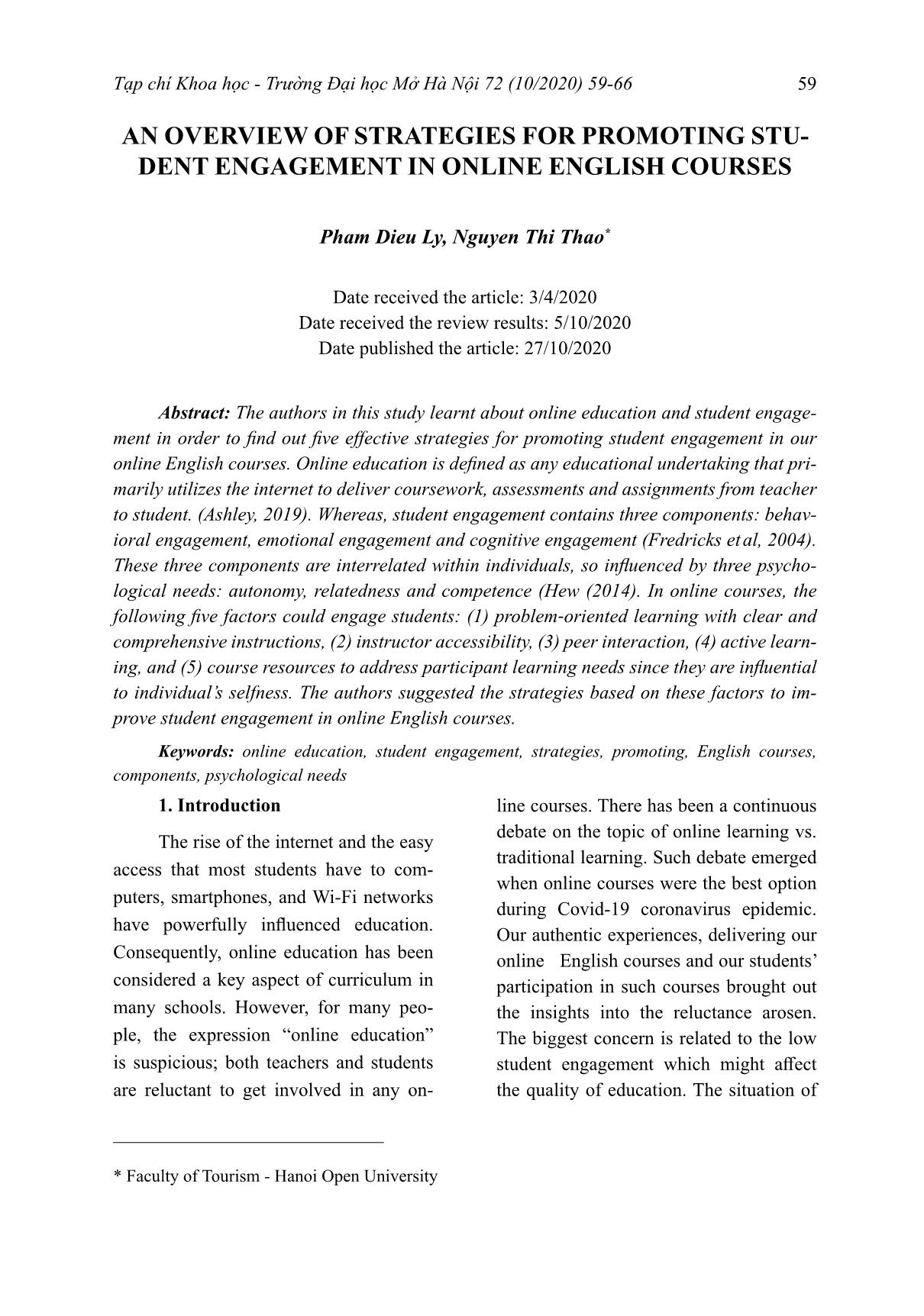
Trang 1
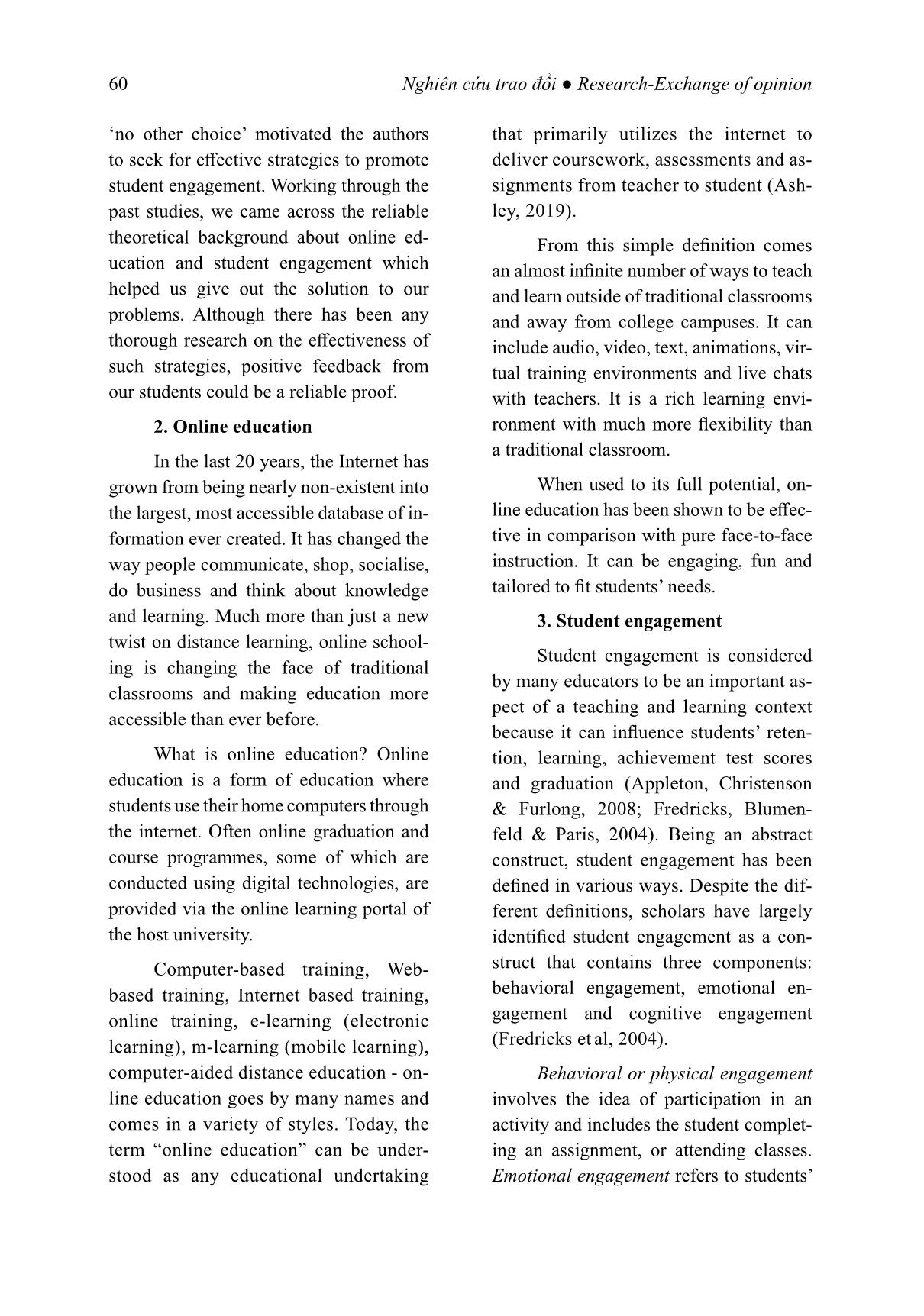
Trang 2
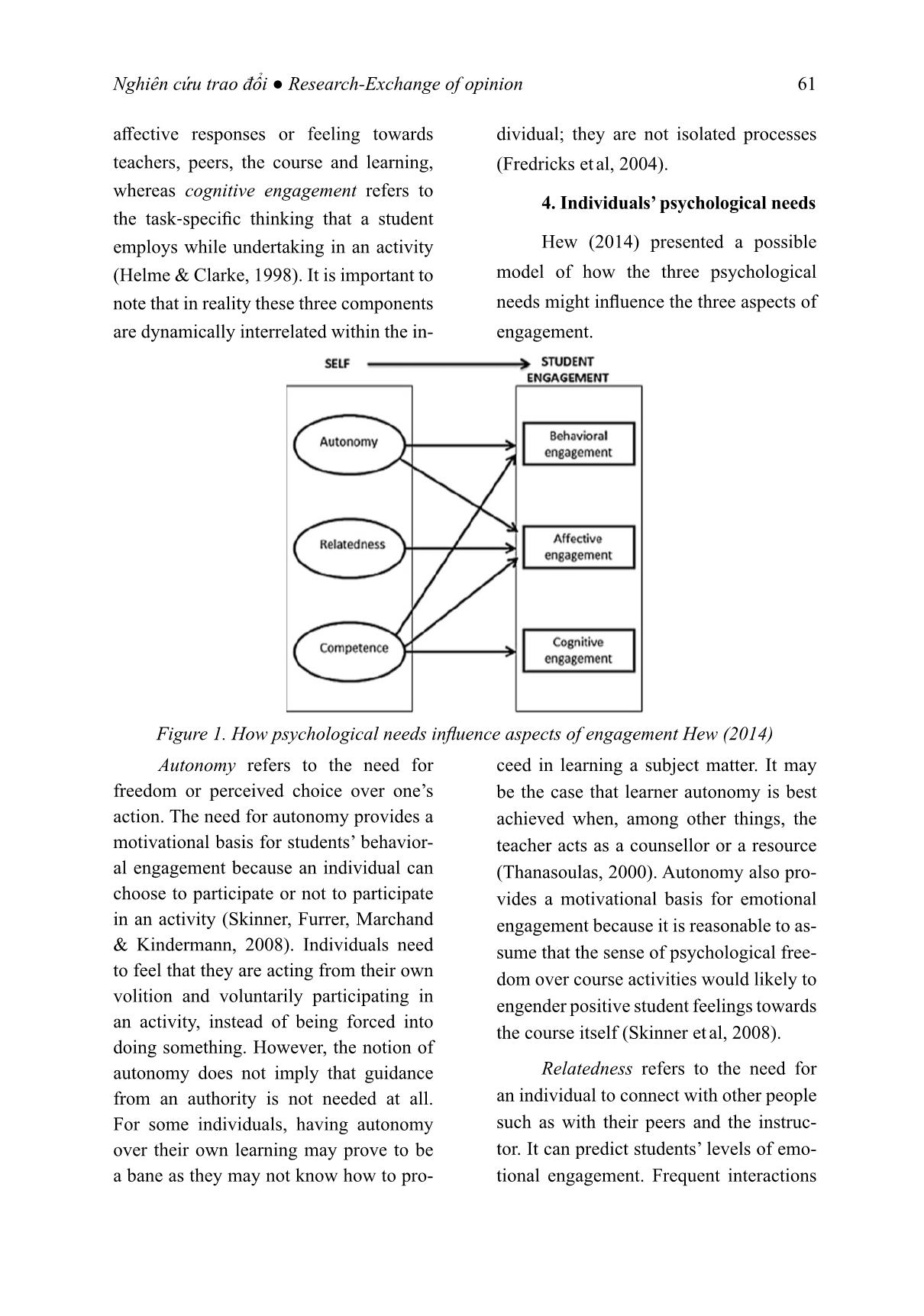
Trang 3
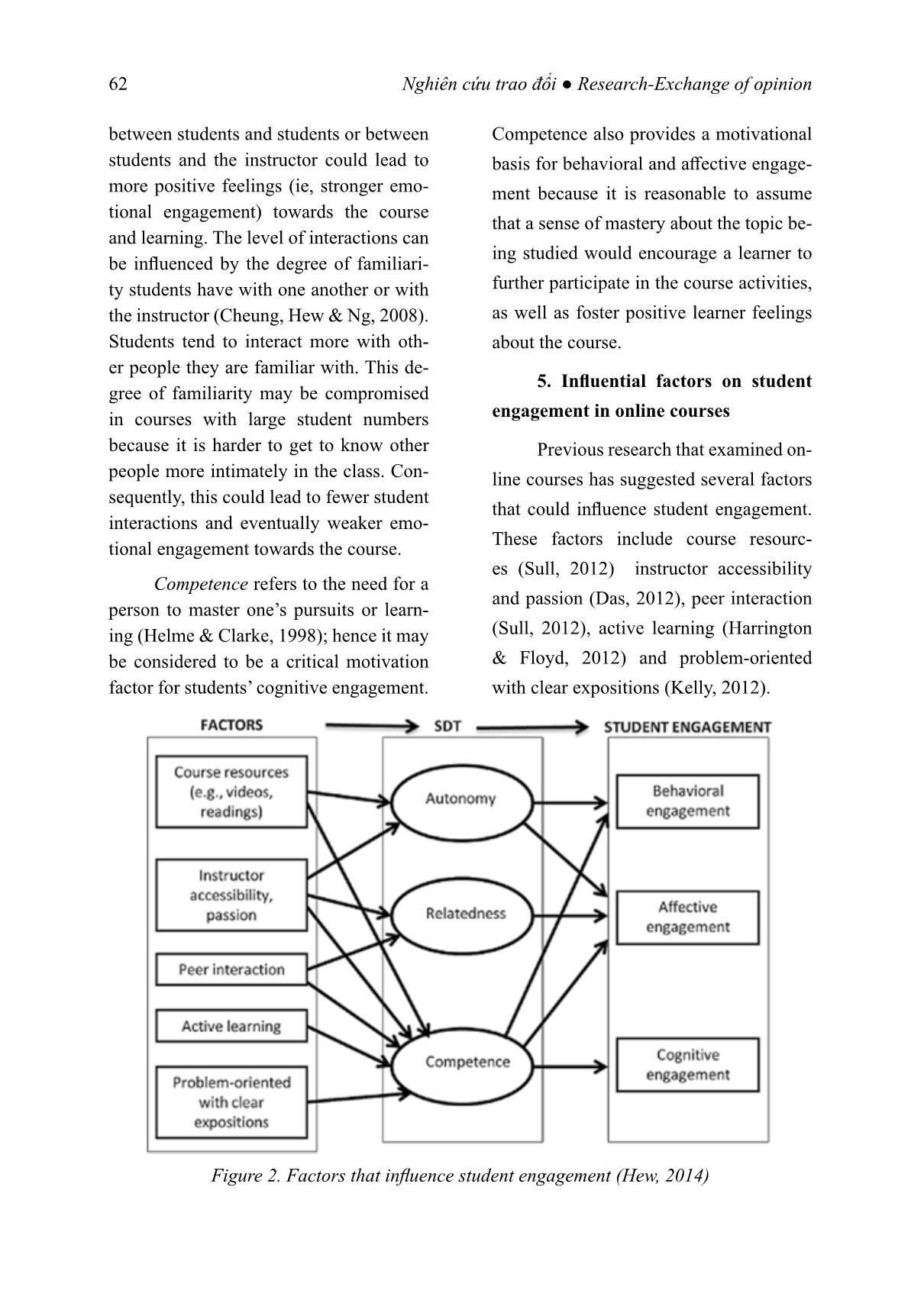
Trang 4
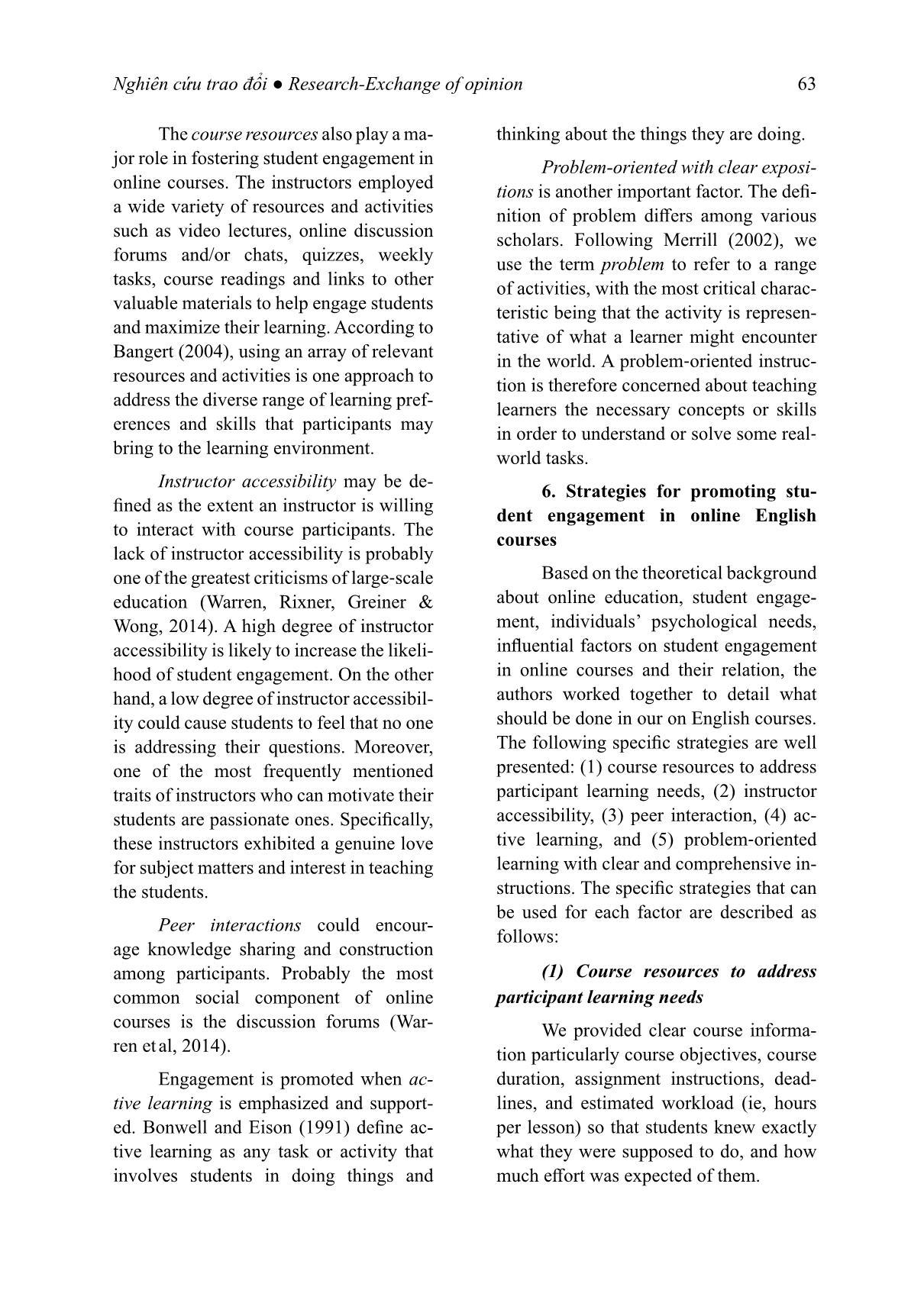
Trang 5
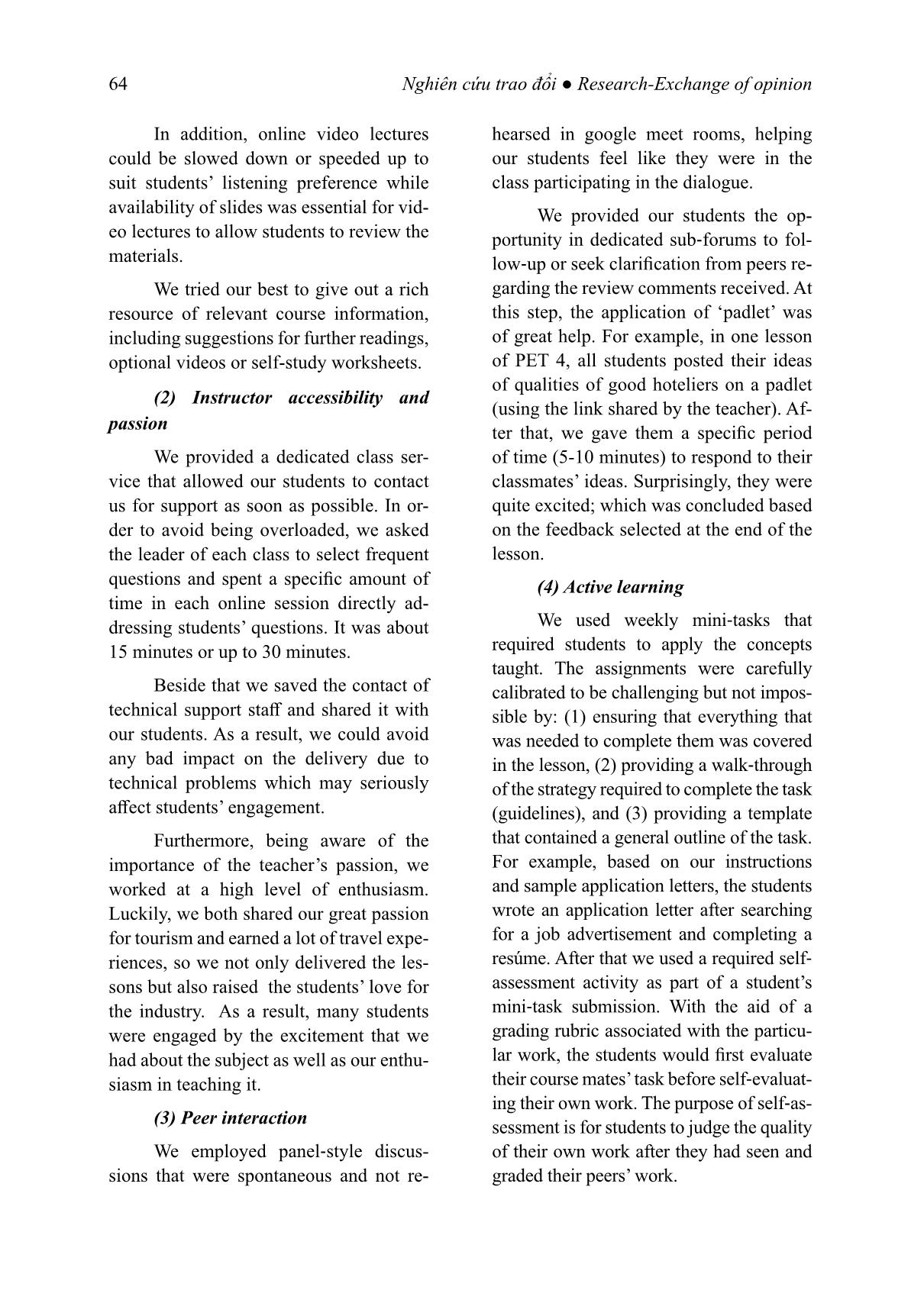
Trang 6
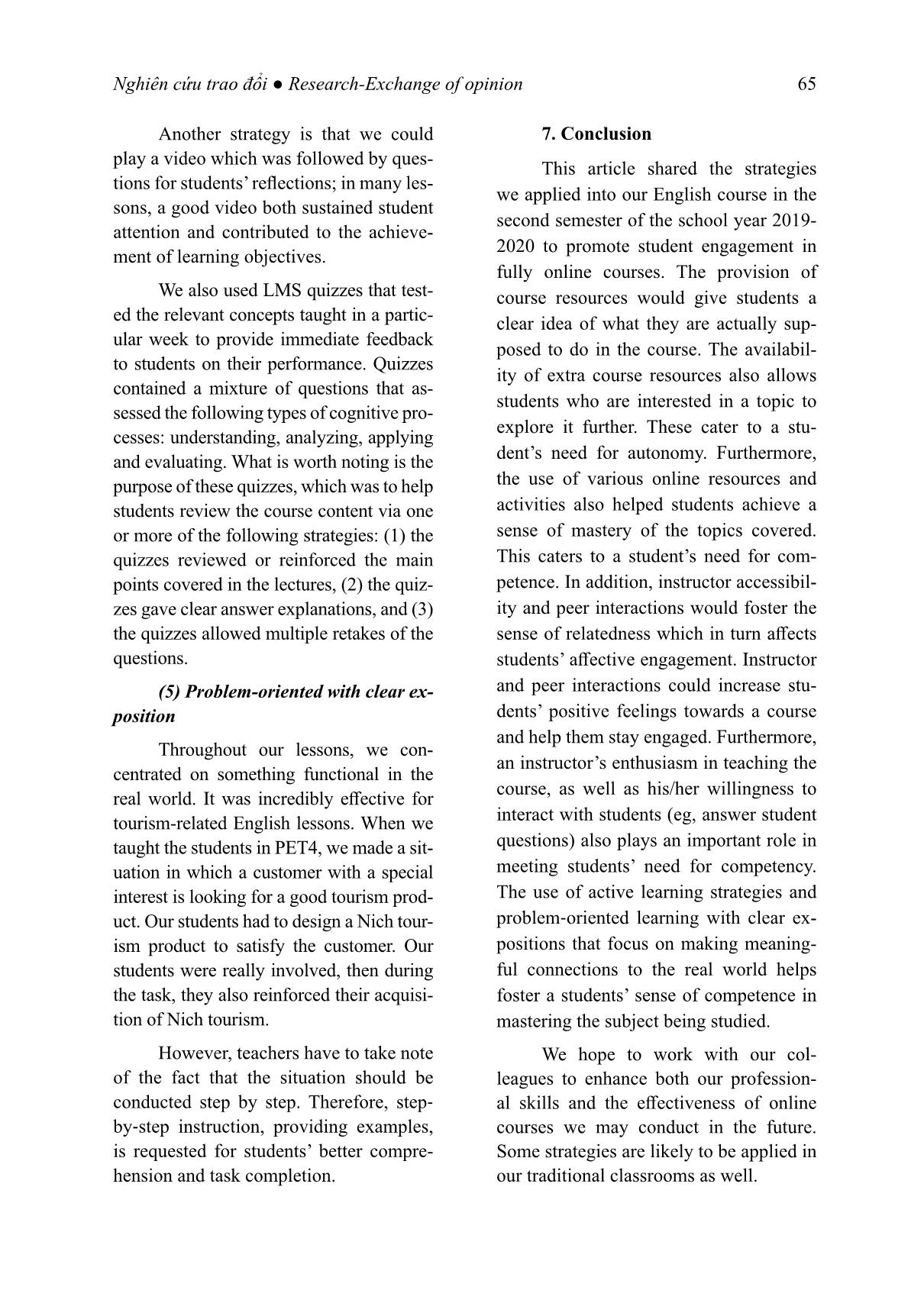
Trang 7
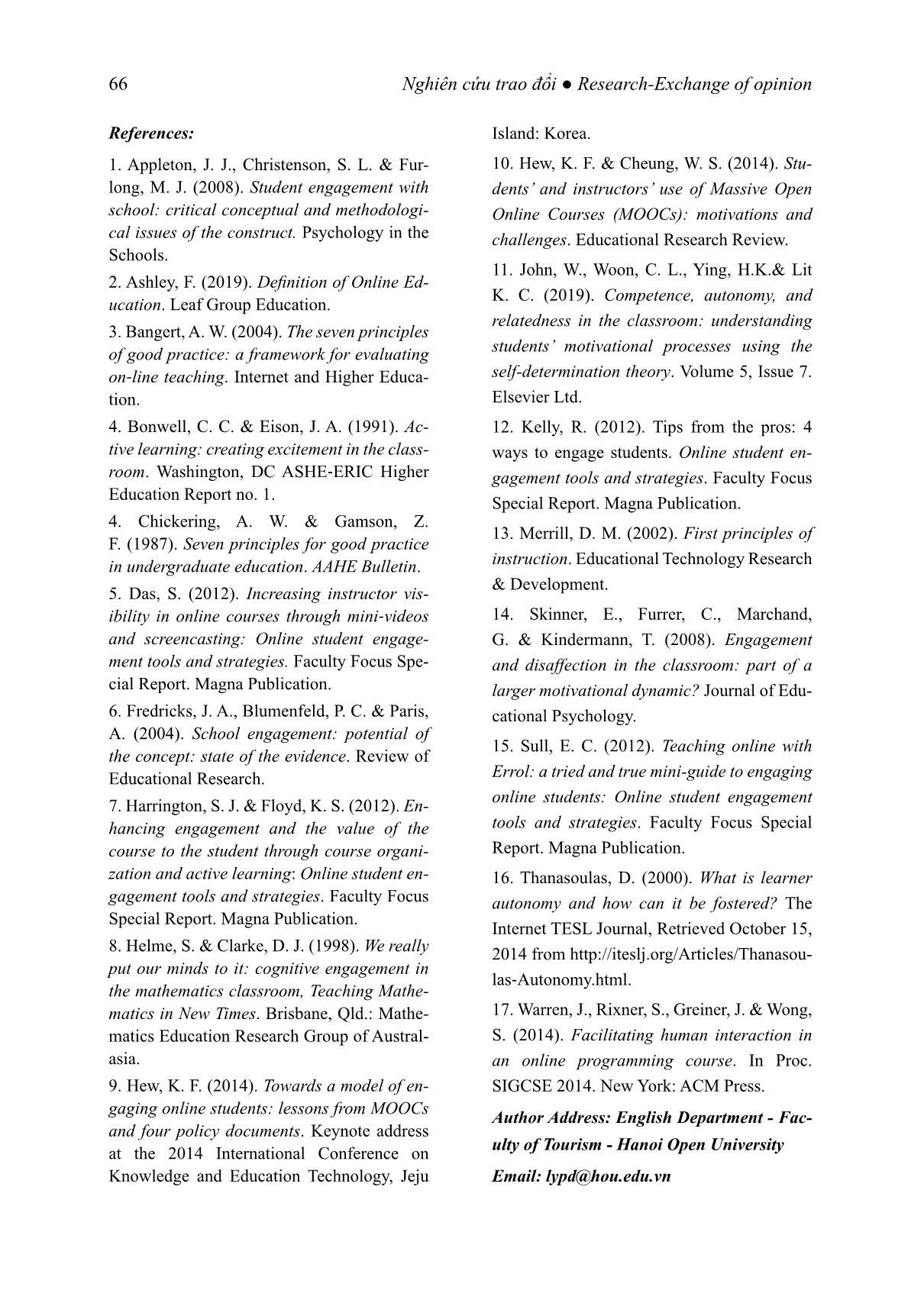
Trang 8
Tóm tắt nội dung tài liệu: An overview of strategies for promoting student engagement in online english courses
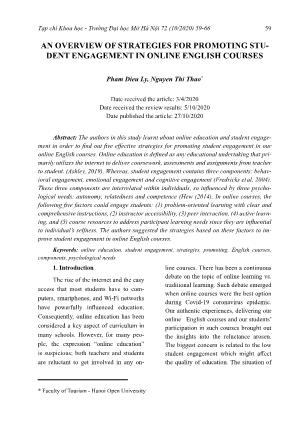
59Nghiên cứu trao đổi ● Research-Exchange of opinion AN OVERVIEW OF STRATEGIES FOR PROMOTING STU- DENT ENGAGEMENT IN ONLINE ENGLISH COURSES Pham Dieu Ly, Nguyen Thi Thao* Date received the article: 3/4/2020 Date received the review results: 5/10/2020 Date published the article: 27/10/2020 Abstract: The authors in this study learnt about online education and student engage- ment in order to fi nd out fi ve eff ective strategies for promoting student engagement in our online English courses. Online education is defi ned as any educational undertaking that pri- marily utilizes the internet to deliver coursework, assessments and assignments from teacher to student. (Ashley, 2019). Whereas, student engagement contains three components: behav- ioral engagement, emotional engagement and cognitive engagement (Fredricks et al, 2004). These three components are interrelated within individuals, so infl uenced by three psycho- logical needs: autonomy, relatedness and competence (Hew (2014). In online courses, the following fi ve factors could engage students: (1) problem-oriented learning with clear and comprehensive instructions, (2) instructor accessibility, (3) peer interaction, (4) active learn- ing, and (5) course resources to address participant learning needs since they are infl uential to individual’s selfness. The authors suggested the strategies based on these factors to im- prove student engagement in online English courses. Keywords: online education, student engagement, strategies, promoting, English courses, components, psychological needs * Faculty of Tourism - Hanoi Open University 1. Introduction The rise of the internet and the easy access that most students have to com- puters, smartphones, and Wi-Fi networks have powerfully infl uenced education. Consequently, online education has been considered a key aspect of curriculum in many schools. However, for many peo- ple, the expression “online education” is suspicious; both teachers and students are reluctant to get involved in any on- line courses. There has been a continuous debate on the topic of online learning vs. traditional learning. Such debate emerged when online courses were the best option during Covid-19 coronavirus epidemic. Our authentic experiences, delivering our online English courses and our students’ participation in such courses brought out the insights into the reluctance arosen. The biggest concern is related to the low student engagement which might aff ect the quality of education. The situation of Tạp chí Khoa học - Trường Đại học Mở Hà Nội 72 (10/2020) 59-66 60 Nghiên cứu trao đổi ● Research-Exchange of opinion ‘no other choice’ motivated the authors to seek for eff ective strategies to promote student engagement. Working through the past studies, we came across the reliable theoretical background about online ed- ucation and student engagement which helped us give out the solution to our problems. Although there has been any thorough research on the eff ectiveness of such strategies, positive feedback from our students could be a reliable proof. 2. Online education In the last 20 years, the Internet has grown from being nearly non-existent into the largest, most accessible database of in- formation ever created. It has changed the way people communicate, shop, socialise, do business and think about knowledge and learning. Much more than just a new twist on distance learning, online school- ing is changing the face of traditional classrooms and making education more accessible than ever before. What is online education? Online education is a form of education where students use their home computers through the internet. Often online graduation and course programmes, some of which are conducted using digital technologies, are provided via the online learning portal of the host university. Computer-based training, Web- based training, Internet based training, online training, e-learning (electronic learning), m-learning (mobile learning), computer-aided distance education - on- line education goes by many names and comes in a variety of styles. Today, the term “online education” can be under- stood as any educational undertaking that primarily utilizes the internet to deliver coursework, assessments and as- signments from teacher to student (Ash- ley, 2019). From this simple definition comes an almost infinite number of ways to teach and learn outside of traditional classrooms and away from college campuses. It can include audio, video, text, animations, vir- tual training environments and live chats with teachers. It is a rich learning envi- ronment with much more flexibility than a traditional classroom. When used to its full potential, on- line education has been shown to be eff ec- tive in comparison with pure face-to-face instruction. It can be engaging, fun and tailored to fit students’ needs. 3. Student engagement Student engagement is considered by many educators to be an important as- pect of a teaching and learning context because it can infl uence students’ reten- tion, learning, achievement test scores and graduation (Appleton, Christenson & Furlong, 2008; Fredricks, Blumen- feld & Paris, 2004). Being an abstract construct, student engagement has been defi ned in various ways. Despite the dif- ferent defi nitions, scholars have largely identifi ed student engagement as a con- struct that contains three components: behavioral engagement, emotional en- gagement and cognitive engagement (Fredricks et al, 2004). Behavioral or physical engagement involves the idea of participation in an activity and includes the student complet- ing an assignment, or attending classes. Emotional engagement refers to students’ 61Nghiên cứu trao đổi ● Research-Exchange of opinion aff ective responses or feeling towa ... igure 2. Factors that infl uence student engagement (Hew, 2014) 63Nghiên cứu trao đổi ● Research-Exchange of opinion The course resources also play a ma- jor role in fostering student engagement in online courses. The instructors employed a wide variety of resources and activities such as video lectures, online discussion forums and/or chats, quizzes, weekly tasks, course readings and links to other valuable materials to help engage students and maximize their learning. According to Bangert (2004), using an array of relevant resources and activities is one approach to address the diverse range of learning pref- erences and skills that participants may bring to the learning environment. Instructor accessibility may be de- fi ned as the extent an instructor is willing to interact with course participants. The lack of instructor accessibility is probably one of the greatest criticisms of large-scale education (Warren, Rixner, Greiner & Wong, 2014). A high degree of instructor accessibility is likely to increase the likeli- hood of student engagement. On the other hand, a low degree of instructor accessibil- ity could cause students to feel that no one is addressing their questions. Moreover, one of the most frequently mentioned traits of instructors who can motivate their students are passionate ones. Specifi cally, these instructors exhibited a genuine love for subject matters and interest in teaching the students. Peer interactions could encour- age knowledge sharing and construction among participants. Probably the most common social component of online courses is the discussion forums (War- ren et al, 2014). Engagement is promoted when ac- tive learning is emphasized and support- ed. Bonwell and Eison (1991) defi ne ac- tive learning as any task or activity that involves students in doing things and thinking about the things they are doing. Problem-oriented with clear exposi- tions is another important factor. The defi - nition of problem diff ers among various scholars. Following Merrill (2002), we use the term problem to refer to a range of activities, with the most critical charac- teristic being that the activity is represen- tative of what a learner might encounter in the world. A problem-oriented instruc- tion is therefore concerned about teaching learners the necessary concepts or skills in order to understand or solve some real- world tasks. 6. Strategies for promoting stu- dent engagement in online English courses Based on the theoretical background about online education, student engage- ment, individuals’ psychological needs, infl uential factors on student engagement in online courses and their relation, the authors worked together to detail what should be done in our on English courses. The following specifi c strategies are well presented: (1) course resources to address participant learning needs, (2) instructor accessibility, (3) peer interaction, (4) ac- tive learning, and (5) problem-oriented learning with clear and comprehensive in- structions. The specifi c strategies that can be used for each factor are described as follows: (1) Course resources to address participant learning needs We provided clear course informa- tion particularly course objectives, course duration, assignment instructions, dead- lines, and estimated workload (ie, hours per lesson) so that students knew exactly what they were supposed to do, and how much eff ort was expected of them. 64 Nghiên cứu trao đổi ● Research-Exchange of opinion In addition, online video lectures could be slowed down or speeded up to suit students’ listening preference while availability of slides was essential for vid- eo lectures to allow students to review the materials. We tried our best to give out a rich resource of relevant course information, including suggestions for further readings, optional videos or self-study worksheets. (2) Instructor accessibility and passion We provided a dedicated class ser- vice that allowed our students to contact us for support as soon as possible. In or- der to avoid being overloaded, we asked the leader of each class to select frequent questions and spent a specifi c amount of time in each online session directly ad- dressing students’ questions. It was about 15 minutes or up to 30 minutes. Beside that we saved the contact of technical support staff and shared it with our students. As a result, we could avoid any bad impact on the delivery due to technical problems which may seriously aff ect students’ engagement. Furthermore, being aware of the importance of the teacher’s passion, we worked at a high level of enthusiasm. Luckily, we both shared our great passion for tourism and earned a lot of travel expe- riences, so we not only delivered the les- sons but also raised the students’ love for the industry. As a result, many students were engaged by the excitement that we had about the subject as well as our enthu- siasm in teaching it. (3) Peer interaction We employed panel-style discus- sions that were spontaneous and not re- hearsed in google meet rooms, helping our students feel like they were in the class participating in the dialogue. We provided our students the op- portunity in dedicated sub-forums to fol- low-up or seek clarifi cation from peers re- garding the review comments received. At this step, the application of ‘padlet’ was of great help. For example, in one lesson of PET 4, all students posted their ideas of qualities of good hoteliers on a padlet (using the link shared by the teacher). Af- ter that, we gave them a specifi c period of time (5-10 minutes) to respond to their classmates’ ideas. Surprisingly, they were quite excited; which was concluded based on the feedback selected at the end of the lesson. (4) Active learning We used weekly mini-tasks that required students to apply the concepts taught. The assignments were carefully calibrated to be challenging but not impos- sible by: (1) ensuring that everything that was needed to complete them was covered in the lesson, (2) providing a walk-through of the strategy required to complete the task (guidelines), and (3) providing a template that contained a general outline of the task. For example, based on our instructions and sample application letters, the students wrote an application letter after searching for a job advertisement and completing a resúme. After that we used a required self- assessment activity as part of a student’s mini-task submission. With the aid of a grading rubric associated with the particu- lar work, the students would fi rst evaluate their course mates’ task before self-evaluat- ing their own work. The purpose of self-as- sessment is for students to judge the quality of their own work after they had seen and graded their peers’ work. 65Nghiên cứu trao đổi ● Research-Exchange of opinion Another strategy is that we could play a video which was followed by ques- tions for students’ refl ections; in many les- sons, a good video both sustained student attention and contributed to the achieve- ment of learning objectives. We also used LMS quizzes that test- ed the relevant concepts taught in a partic- ular week to provide immediate feedback to students on their performance. Quizzes contained a mixture of questions that as- sessed the following types of cognitive pro- cesses: understanding, analyzing, applying and evaluating. What is worth noting is the purpose of these quizzes, which was to help students review the course content via one or more of the following strategies: (1) the quizzes reviewed or reinforced the main points covered in the lectures, (2) the quiz- zes gave clear answer explanations, and (3) the quizzes allowed multiple retakes of the questions. (5) Problem‐oriented with clear ex- position Throughout our lessons, we con- centrated on something functional in the real world. It was incredibly eff ective for tourism-related English lessons. When we taught the students in PET4, we made a sit- uation in which a customer with a special interest is looking for a good tourism prod- uct. Our students had to design a Nich tour- ism product to satisfy the customer. Our students were really involved, then during the task, they also reinforced their acquisi- tion of Nich tourism. However, teachers have to take note of the fact that the situation should be conducted step by step. Therefore, step- by-step instruction, providing examples, is requested for students’ better compre- hension and task completion. 7. Conclusion This article shared the strategies we applied into our English course in the second semester of the school year 2019- 2020 to promote student engagement in fully online courses. The provision of course resources would give students a clear idea of what they are actually sup- posed to do in the course. The availabil- ity of extra course resources also allows students who are interested in a topic to explore it further. These cater to a stu- dent’s need for autonomy. Furthermore, the use of various online resources and activities also helped students achieve a sense of mastery of the topics covered. This caters to a student’s need for com- petence. In addition, instructor accessibil- ity and peer interactions would foster the sense of relatedness which in turn aff ects students’ aff ective engagement. Instructor and peer interactions could increase stu- dents’ positive feelings towards a course and help them stay engaged. Furthermore, an instructor’s enthusiasm in teaching the course, as well as his/her willingness to interact with students (eg, answer student questions) also plays an important role in meeting students’ need for competency. The use of active learning strategies and problem-oriented learning with clear ex- positions that focus on making meaning- ful connections to the real world helps foster a students’ sense of competence in mastering the subject being studied. We hope to work with our col- leagues to enhance both our profession- al skills and the eff ectiveness of online courses we may conduct in the future. Some strategies are likely to be applied in our traditional classrooms as well. 66 Nghiên cứu trao đổi ● Research-Exchange of opinion References: 1. Appleton, J. J., Christenson, S. L. & Fur- long, M. J. (2008). Student engagement with school: critical conceptual and methodologi- cal issues of the construct. Psychology in the Schools. 2. Ashley, F. (2019). Defi nition of Online Ed- ucation. Leaf Group Education. 3. Bangert, A. W. (2004). The seven principles of good practice: a framework for evaluating on-line teaching. Internet and Higher Educa- tion. 4. Bonwell, C. C. & Eison, J. A. (1991). Ac- tive learning: creating excitement in the class- room. Washington, DC ASHE-ERIC Higher Education Report no. 1. 4. Chickering, A. W. & Gamson, Z. F. (1987). Seven principles for good practice in undergraduate education. AAHE Bulletin. 5. Das, S. (2012). Increasing instructor vis- ibility in online courses through mini-videos and screencasting: Online student engage- ment tools and strategies. Faculty Focus Spe- cial Report. Magna Publication. 6. Fredricks, J. A., Blumenfeld, P. C. & Paris, A. (2004). School engagement: potential of the concept: state of the evidence. Review of Educational Research. 7. Harrington, S. J. & Floyd, K. S. (2012). En- hancing engagement and the value of the course to the student through course organi- zation and active learning: Online student en- gagement tools and strategies. Faculty Focus Special Report. Magna Publication. 8. Helme, S. & Clarke, D. J. (1998). We really put our minds to it: cognitive engagement in the mathematics classroom, Teaching Mathe- matics in New Times. Brisbane, Qld.: Mathe- matics Education Research Group of Austral- asia. 9. Hew, K. F. (2014). Towards a model of en- gaging online students: lessons from MOOCs and four policy documents. Keynote address at the 2014 International Conference on Knowledge and Education Technology, Jeju Island: Korea. 10. Hew, K. F. & Cheung, W. S. (2014). Stu- dents’ and instructors’ use of Massive Open Online Courses (MOOCs): motivations and challenges. Educational Research Review. 11. John, W., Woon, C. L., Ying, H.K.& Lit K. C. (2019). Competence, autonomy, and relatedness in the classroom: understanding students’ motivational processes using the self-determination theory. Volume 5, Issue 7. Elsevier Ltd. 12. Kelly, R. (2012). Tips from the pros: 4 ways to engage students. Online student en- gagement tools and strategies. Faculty Focus Special Report. Magna Publication. 13. Merrill, D. M. (2002). First principles of instruction. Educational Technology Research & Development. 14. Skinner, E., Furrer, C., Marchand, G. & Kindermann, T. (2008). Engagement and disaff ection in the classroom: part of a larger motivational dynamic? Journal of Edu- cational Psychology. 15. Sull, E. C. (2012). Teaching online with Errol: a tried and true mini‐guide to engaging online students: Online student engagement tools and strategies. Faculty Focus Special Report. Magna Publication. 16. Thanasoulas, D. (2000). What is learner autonomy and how can it be fostered? The Internet TESL Journal, Retrieved October 15, 2014 from las-Autonomy.html. 17. Warren, J., Rixner, S., Greiner, J. & Wong, S. (2014). Facilitating human interaction in an online programming course. In Proc. SIGCSE 2014. New York: ACM Press. Author Address: English Department - Fac- ulty of Tourism - Hanoi Open University Email: lypd@hou.edu.vn
File đính kèm:
 an_overview_of_strategies_for_promoting_student_engagement_i.pdf
an_overview_of_strategies_for_promoting_student_engagement_i.pdf

